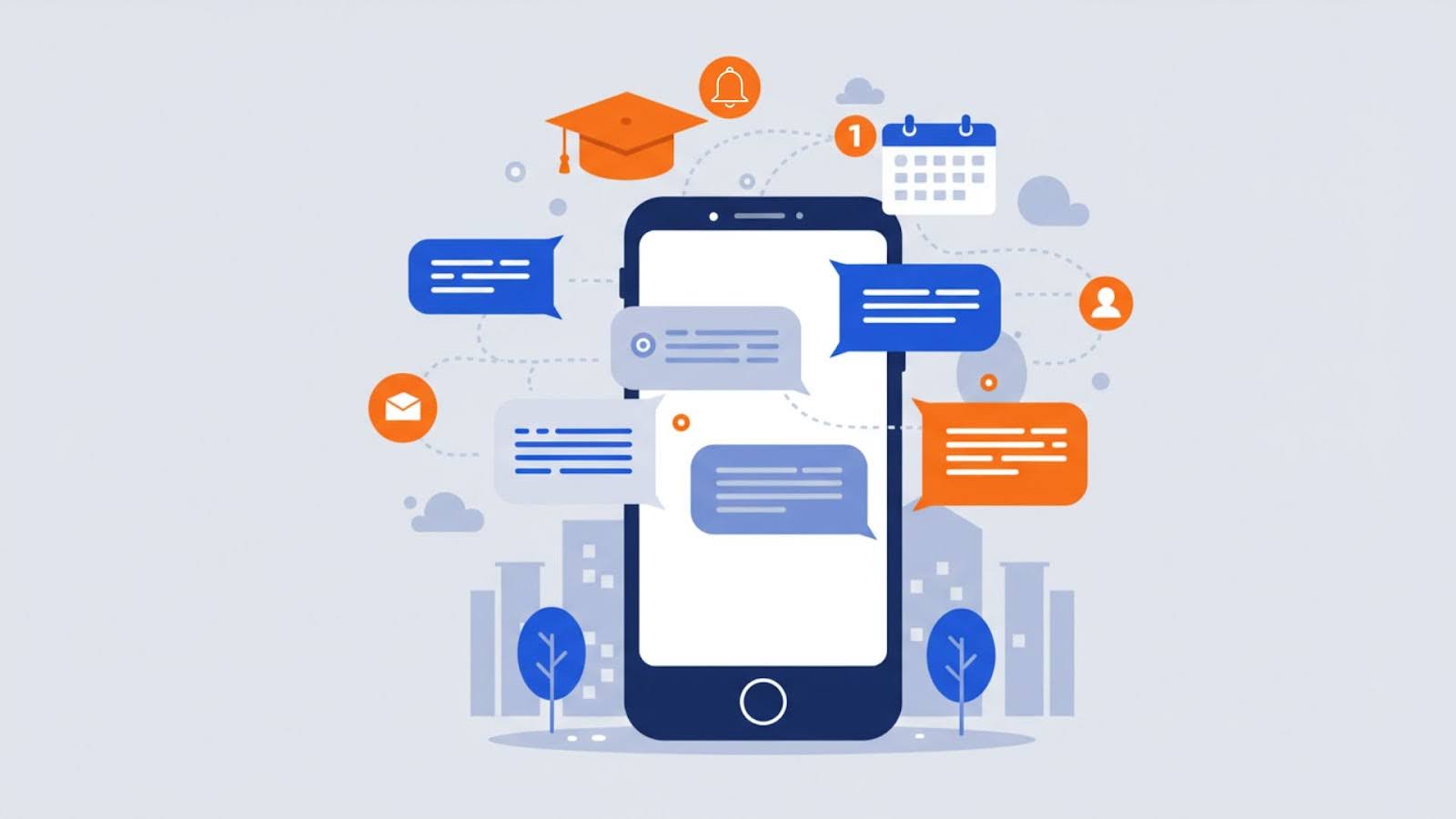The Future of Campus Communication: Trends in 2025
Campus communication is undergoing a digital transformation driven by AI, mobile technology and student expectations.
- AI-powered personalization is enabling one-to-one conversations at scale
- SMS messaging achieves 98% open rates versus just over a quarter for email
- Mobile-first platforms are centralizing previously fragmented systems
- Real-time, two-way communication is becoming the baseline expectation
Institutions that embrace these trends will see higher engagement, improved retention and stronger student relationships.
The days of posting notices on bulletin boards and hoping students check their email are officially over. Today's campus communication looks nothing like it did even five years ago. Digital-native expectations are finally reshaping how institutions connect with their communities.
Higher education is experiencing continuous transformation to meet changing student and staff needs while maintaining sustainable practices. It's time to rethink how we build relationships with learners throughout their entire educational journey.
Students expect conversations, not just information delivery. Gen Z spends over 7 hours daily on their smartphones, making these devices central to their daily lives. As educational consumers, they're investing in an experience that should connect every aspect of their academic and social lives.
How Is Campus Communication Changing in 2025?
The shift happening across campuses nationwide represents more than technological upgrades. We're witnessing a complete reimagining of what it means to stay connected in an educational environment.
From Broadcast to Conversation: The Shift to Two-Way Communication
Traditional campus communication operated like a radio station. Institutions broadcast information and hoped someone was listening. But modern students expect dialogue. They want to ask questions, get immediate responses and feel heard by their institutions.
Generation Z interacts differently with organizations than previous student groups. Research shows that 69% of students expect their university to understand their unique needs within all communication channels. With higher education facing ongoing enrollment challenges and changing student demographics, institutions must adapt their communication strategies. Students want to feel like individuals, not numbers in a database.
The most successful institutions are moving beyond mass email blasts to create genuine conversation opportunities. When students can text questions about financial aid deadlines and get personalized responses within minutes, they develop stronger connections to their campus community.
Mobile-First Becomes Mobile-Only for Gen Z Students
Your students are not checking email on desktop computers. They're scrolling through their phones during class breaks, between work shifts and before falling asleep. With 98% of Americans now owning cellphones, mobile devices have become their primary gateway to campus information.
This reality demands more than mobile-responsive websites. Students need communication channels that work within their existing mobile behaviors. They want to receive important updates through the same device they use for everything else, without having to download multiple apps or remember different login credentials.
Campus communication strategies that ignore this mobile-first reality are essentially choosing to be invisible to their students. Institutions that embrace mobile-native communication see dramatically higher engagement rates and stronger student relationships.
AI Integration: Scaling Personal Touch
Artificial intelligence is finally living up to its promise in higher education. We're talking about enhancing communication. The most effective AI implementations blend automated efficiency with authentic human conversation.

Smart communication systems can now recognize when a student needs immediate human support versus when an automated response will suffice. They can personalize messages based on academic progress, involvement level and individual preferences without requiring staff to manually craft each interaction.
This AI-enhanced approach allows institutions to maintain personal connections even as enrollment grows. Students receive timely, relevant information while staff focus their energy on complex support situations that require human expertise.
Why Are Traditional Communication Methods Failing Students?
Understanding the problems with current approaches helps explain why change is so urgent. Traditional communication methods weren't designed for today's student expectations or technological capabilities.
The Email Problem: Why Student Messages Go Unread
Email served higher education well for decades, but it's become a victim of its own success. Students' inboxes overflow with messages from multiple departments, creating a situation where important information gets buried under routine announcements.
While 98% of text messages are read compared to just 26.8% of emails, many institutions still rely primarily on email for critical student communications. Nearly three out of four email recipients may miss important deadlines, support resources or engagement opportunities when institutions rely solely on email.
Email's asynchronous nature compounds the problem. When a student has an urgent question about registration or financial aid, waiting 24–48 hours for an email response feels like an eternity. By the time help arrives, the moment for action may have passed.
Information Overload and Channel Fragmentation
Students navigate a maze of disconnected communication platforms. They might receive course updates through one system, financial aid information via email, campus event invitations through social media and emergency alerts via text. This fragmentation creates confusion and increases the likelihood that important information falls through the cracks.
Each additional platform requires students to remember another login, check another inbox and learn another interface. Multiple communication channels often complicate campus life rather than simplifying it . Students deserve a more streamlined experience that respects their time and cognitive load.
Meeting Students Where They Are: Beyond Traditional Assumptions
Institutions that continue operating under pre-digital assumptions about student communication preferences will find themselves disconnected from their communities. Students vote with their attention, and they're giving this attention to platforms and institutions that understand their communication needs.
The most successful institutions recognize that communication technology is ultimately about relationship building, not just information sharing. They understand that meeting students on their preferred platforms creates opportunities for meaningful engagement.
What Communication Technologies Are Leading Campus Innovation?
Several technologies are emerging as game-changers for campus communication, each addressing specific limitations of traditional approaches while opening new possibilities for student engagement.
1. Conversational SMS Platforms
Text messaging represents the biggest opportunity in campus communication. SMS for colleges achieves response rates of 45% compared to email's 10%, making it the most effective channel for time-sensitive communications.

The most effective platforms enable genuine two-way conversations between students and staff. Students can ask questions about deadlines, request support with registration or get help navigating campus resources, all through familiar text messaging interfaces.
Advanced SMS platforms integrate with student information systems to personalize messages based on academic status, major, housing situation and other relevant factors. This level of targeting ensures students receive only relevant information while reducing message fatigue.
2. AI-Powered Chatbots and Virtual Assistants
Intelligent chatbots are supporting after-hours student support. These systems can handle routine questions about deadlines, locations and procedures while escalating complex issues to human staff members.
Students can get immediate answers to basic questions at any time, while complex support situations receive appropriate human attention during business hours.
3. Unified Mobile Campus Apps
Leading institutions are consolidating services into comprehensive mobile platforms. These apps become digital student life assistants, integrating everything from course schedules to campus dining options.
Successful campus apps focus on convenience and personalization. Students can register for classes, check grades, find events and connect with campus resources through a single, intuitive interface that learns their preferences over time.
4. Multi-Channel Emergency Alert Systems
Campus safety requires communication systems that reach everyone, regardless of their preferred platform or current activity. Modern emergency alert systems combine SMS, email, campus app notifications, digital signage and public address systems to ensure critical information reaches the entire campus community.
These systems recognize that no single communication channel guarantees universal reach during emergencies. By deploying alerts across multiple platforms simultaneously, institutions maximize the likelihood that every community member receives life-saving information.
5. Personalized Push Notification Systems
Strategic push notifications help students stay on top of important deadlines and opportunities without overwhelming them with information. Smart notification systems learn from student behavior, adjusting frequency and timing to maximize engagement while respecting individual preferences.
The key lies in relevance and timing. Students appreciate notifications about registration deadlines for their specific program, but they'll quickly disable notifications that feel generic or excessive. Understanding how Gen Z prospects want to receive communications is essential for developing effective notification strategies.
How Can Institutions Implement Next-Generation Campus Communication?
Successfully modernizing communication requires planning, buy-in and phased implementation. The institutions seeing the best results start with high-impact quick wins before expanding to comprehensive systems.
Starting with SMS: The Highest Impact Quick Win
Text messaging offers the fastest path to improved student engagement because it works within existing student behaviors. They already text constantly; institutions just need to join those conversations appropriately.
Successful implementation of SMS for colleges begins with clear use cases and realistic expectations. Start with time-sensitive communications like registration reminders, payment deadlines or emergency alerts. These scenarios offer immediate value while helping staff and students adjust to text-based communication.
The most important early decision involves choosing between broadcast messaging and conversational platforms. While broadcast systems cost less initially, conversational platforms deliver better engagement and relationship-building outcomes. Students respond more positively when they can ask follow-up questions rather than receiving one-way announcements. Learning how to effectively text students requires understanding both technical capabilities and communication best practices.
Building Integrated Communication Ecosystems
Long-term success requires comprehensive communication strategies. The goal is to create seamless experiences where students can access information and support through their preferred channels while staff can coordinate responses across departments.
Integration with existing campus systems becomes vital at this stage. Communication platforms should connect with student information systems, learning management systems and campus databases to enable personalized, accurate messaging without additional data entry requirements.
Successful implementations also establish clear governance around message frequency, content approval and response protocols. Students should never receive conflicting information from different departments or feel overwhelmed by excessive notifications.
Measuring Success: Analytics That Matter
Effective campus communication requires ongoing measurement and optimization. But engagement metrics tell only part of the story. The most meaningful measurements connect communication effectiveness to student success outcomes.
Track response rates, message read times and student satisfaction scores. Also monitor the correlation between communication engagement and retention rates, academic performance and campus involvement. These connections help demonstrate communication's role in student success while identifying opportunities for improvement.
Regular feedback collection from both students and staff ensures strategies evolve with changing needs and preferences. What works during freshman orientation may need adjustment for senior year communications or graduate student outreach.
Frequently Asked Questions
Q: How quickly can institutions implement modern campus communication systems? A: Most institutions can begin SMS messaging programs relatively quickly, while comprehensive communication platform implementations vary based on integration requirements, campus size and existing technology infrastructure.
Q: What's the biggest challenge in modernizing campus communication? A: Getting buy-in across departments and establishing consistent messaging protocols. Technical implementation is often easier than organizational coordination.
Q: How do institutions ensure compliance when using SMS for student communication? A: Successful programs follow TCPA guidelines for consent, maintain clear opt-out procedures and integrate with existing FERPA compliance protocols for student data protection.
Q: What benefits can institutions expect from improved campus communication? A: Institutions typically see improvements in student engagement metrics, increases in event attendance and measurable improvements in retention rates.
Building Tomorrow's Connected Campus Today
The future of campus communication is happening right now on campuses that recognize the urgency of meeting students where they are. These institutions understand that communication technology is about relationship building.

Students expect their institutions to communicate with the same sophistication and personalization they experience from leading consumer brands. They want immediate responses to urgent questions, personalized guidance through complex processes and consistent support throughout their academic journeys.
Modern Campus provides AI-powered conversational messaging and integrated communication platforms specifically designed for higher education's unique needs throughout the entire student lifecycle. With purpose-built solutions that seamlessly blend automated efficiency with authentic human interaction, we help institutions transform how they connect with their communities. Request a demo today to start modernizing your campus communication.
Last updated: September 10, 2025



